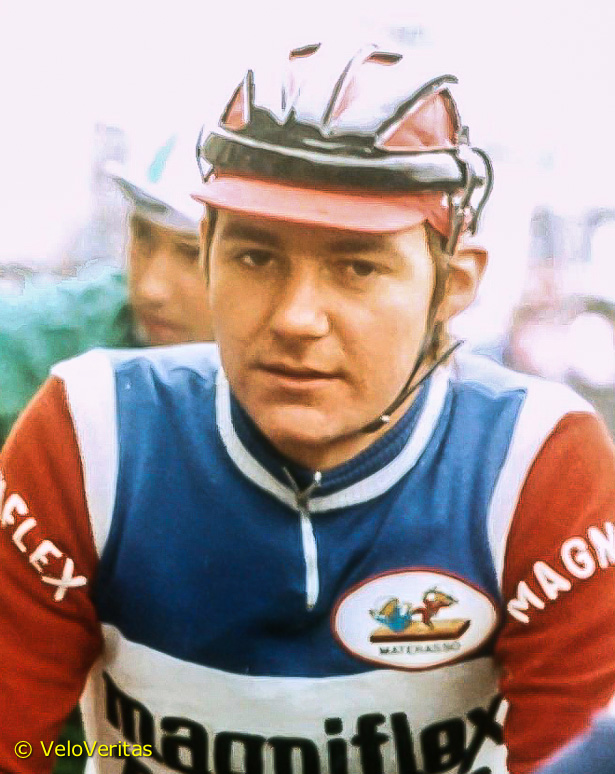
As Michael Matthews and Cadel Evans turn the Giro into a pink Aussie ‘barbie on the beach’ we thought we’d use the rest days to take a look back at one of the men who paved the way for Phil Anderson, Alan Peiper, Cadel Evans, Simon Gerrans and all the other Aussies who now contribute so much to European and world road cycling.Gary Clively rode two-and-a-bit seasons for Magniflex in the mid 70’s, turning pro on the back of a brilliant fourth spot in the 1975 amateur Worlds road race.By the end of that season he was grabbing top ten placings in Italian semi-classics like the Coppa Agostoni.
The 1976 season saw a whole raft of good performances; seventh in the Trofeo Laigueglia, second in the GP Camaiore, third in the Giro della Provincia di Reggio Calabria, third in Sassari-Cagliari and a ride in the Giro.
His stand out result in 1977 was seventh in the Vuelta, one place behind Michel Pollentier.
He never returned to Europe for season 1978 and it was the late 80’s before he raced again – winning the Australian Road race Championship.
Here’s his story…
Tell us a little about the Aussie racing scene in the 70’s, please Garry.
“Australian cycling in the early 70’s was very strong at club and state levels; especially in Victoria and New South Wales, with a great many riders filling the ranks from under 16’s right through to senior level, including a large number of older riders who competed as out markers in the then prevalent handicap system of road and track racing. There were hundreds of professional cyclists across the country and even more amateurs competing in separate events.
“Professional cycling was very competitive but not very lucrative, so almost all cyclists worked full time jobs. You had to have a lot of passion for cycling to train, race and work – not to mention have families and all that goes with them.
“Australian cycling had depth, riders began young and their families would usually attend the racing scene with them, so there was always a colourful and highly interactive and supportive scene at club level. Club combines were a bi-monthly feature of the yearly calendar, with an ‘open’ event attracting riders from hundreds of miles every second week during road season and every weekend in the capital of Melbourne during track season.
“Similar to the European scene, cycling in Australia in the 70’s as in the previous few decades, was a vibrant world unto itself, full of characters and wonderfully impressive riders. They are still talked about in cycling circles, but remain unknown outside of Australia.”
Where did the motivation to go to Italy come from?
“From the age of 14, when I started reading stories of Eddy Merckx, Walter Godefroot, Herman Van Springel and Franco Bitossi’s victories in the Classics; then also discovered the Tours through the Miroir du Cyclisme magazine, I had in mind to be there and to experience road racing somewhere in Europe.
“It could have been Belgium too, but circumstances directed me to Italy. I was a besotted teenager who absolutely had to race in Europe.
“It was something a lot of young riders from Australia were beginning to think of doing.”
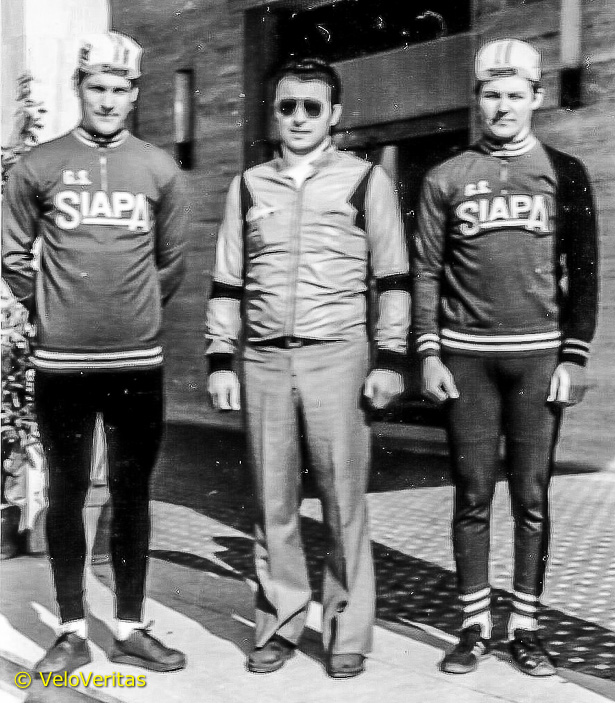
Tell us about GS Siapa who you raced for as an amateur.
“Young David Allan – Don’s younger brother – and I had heard a rumour that a few Aussies were going to head for Italy in early 1974 to try and join an amateur team called Siapa in northern Italy. We found out they would be looking for a man by the name of Harry Luther who was a rep for Shimano and was somehow linked to the team. All we knew was that he lived in a small town south of Ravenna and that he might be able to help us.
“On our arrival there we found out that he was somewhere in Spain and we later learned he’d had a fall out training there and was in hospital. We had very little money and no plan B, so we hunted down the Siapa team director in Ravenna and introduced ourselves. The poor guy just had to laugh at us; David was 17 and I was 18, both with a bike and tiny suitcases and wanting to join his team.
“Mr Luther had not been in a position to hear about us coming so to them we were a complete surprise. They didn’t know about anyone coming from Australia except Clyde Sefton who was due after the Christchurch Commonwealth Games road race. They wanted to turn us away, but I asked if we could just go training with the team a couple of times to see what it would be like to experience at least that much.
“It was all a bizarre joke to them and they must have thought it would be a laugh to lose us both on some climb out in the middle of the countryside and then forget all about us. Of course, we had other plans, this being our only chance to make an impression and get our foot in the door there.
“They weren’t a bad lot and the team generally dominated the regional races. However, they had no idea just what kind of a rider David Allan was. He was really a unique talent. I wasn’t going too badly either and so between the two of us we gave the DS – who followed the run that first day – something to think about by dropping them all, much to our own surprise.
“Being only 17, David was too young for the Siapa cat. 1 and 2 level team, but they kindly found him a team a little south of Ravenna, where he raced that year (winning 18 races no less), while they found a place for me in a cheap hotel and let me join the team, giving me a jersey and a pair of shorts.
“The owner of the team was very kind to me and welcomed me in the most friendly manner, although it was always clear that I had no contract and no income whatsoever except prize money. I couldn’t wait for the team to gather and drive to races because there wasn’t much to eat in that hotel and at least we ate well on the road.”
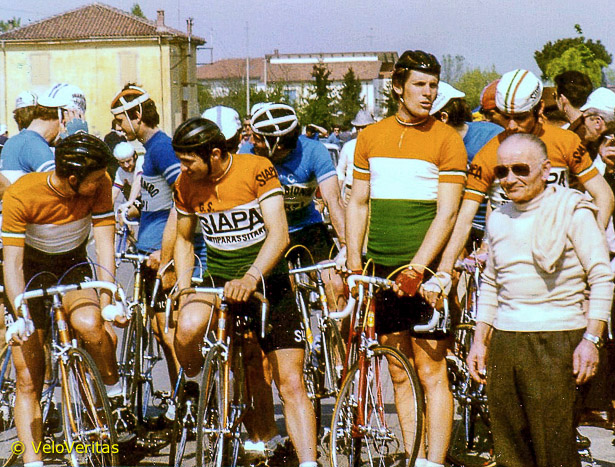
That was a fabulous ride in the 1975 Worlds, tell us about it.
“The race was run in Mettet, Belgium 30th August on a hot Saturday, the day before the elite men’s in Yvoir. There were more riders on the starting line than I’d ever seen before, well over 300.
“Riders from Taiwan, India, Saudi Arabia and who knows where, some even lined up in khaki army shorts with turbans over their helmets.
“It was chaos in the opening laps but the Australian team was lucky as we were up early in the presentation of teams in the line up & avoided the frightful mess in the middle of the peloton. After a lap or two I saw two of these odd looking racers each head for opposite sides of the road into dirt fields, somersaulting out of the roadside ditches as the road bottle necked and they were shunted aside by some hefty looking Russians.
“There were many riders I’d barely heard of from eastern Europe, but I recognised some and was aware of their fearsome reputation for riding with the hammer down.
“A few Belgians I had only just raced with in the weeks before while Mike and I had been in Belgium leading up to the race; Ferdi Van Den Haute, Jean-Luc Vandenbroucke – already adored there as a rider who had delivered much – and Pol Verschuere who beat me a few days earlier in a race near Bruxelles and was in great form. I knew the Italians well but everyone else was new to me and so I set off just hoping I wouldn’t crash on the narrow roads on the back of the circuit and to see if I could go the distance – which was 190km as I recall.
“The first laps were really fast and there were enough hills and cross winds each lap to allow for an early familiarity with the race pattern. The pace would stay high and the heat would make it very hard in the end, especially because getting water apart from one feed was banned for some reason.
“Later on I saw Belgians disqualified in the last lap for taking bottles on the narrow climb beyond the finish line, although I was much luckier in that Aussie sprinter Malcolm Hill handed me a bottle of glucose water at two laps to go in the same spot, just when I was beginning to fade from dehydration and no one blew the whistle on me. That drink really brought me back into the race and I started moving to the head of the group as we came to the final lap, right in time to tack on to the tail end of a group that moved away under the impetus of a Polish rider’s attack on the next hill.
“There were about ten or twelve in the group, from which Verschuere was told to leave for taking water. I actually had no idea we were chasing Sven-Ake Nilsson and Andre Gevers (eventual winner and Raleigh pro, ed.) until I came to the front of that group and I could see them through the motorcade ahead. I figured we wouldn’t have time to catch them unless a couple of the better represented teams sacrificed a rider. I think the heat and the no watering rule decided the day for the chasers because no one could do more than work turns and hold on over the final climbs – and of course both Gevers and Nilsson must have both been on a very good day and deservedly fought it out over top of the last climb.
“Behind them we pressed on and held it together until the final uphill kilometre when after one or two riders tried to break clear I followed the top Polish rider Nowicki who took off as we crested in sight of the line. His sprint was very strong and I couldn’t make an impression on him then I was pipped by Roberto Ceruti for third in our group.
“But Nowicki was disqualified for taking a drink somewhere in the finale and so Ceruti got the bronze and I was given fourth. [Nowicki’s final preparation for the race had been the Scottish Milk Race, which he won – with thanks to Ivan for additional research, ed.]
“Of course I was very pleased to be in such company and to still be going fairly well at the finish.
“The Siapa team owner was there with his family and he gave me a small reward & congratulated me.”
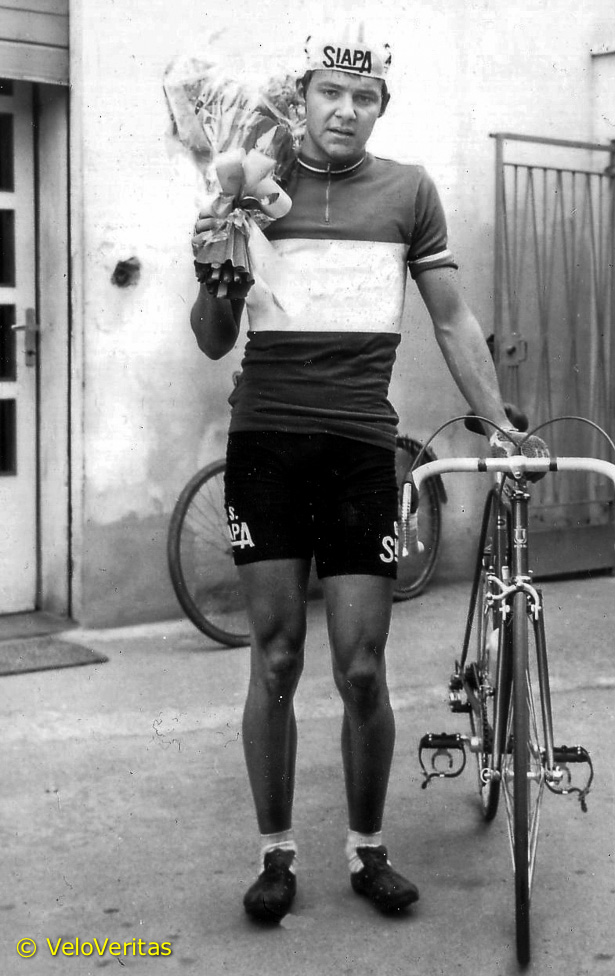
How did the Magniflex ride come about?
“Following Mettet, when I returned to Italy, I was still going well and won the opening mountain stage of the Giro della Val d’Aosta in Piemonte.
“Most of the Italian team had also come back to that race and it was a very good field, so I got some attention for that.
“I had some tendonitis through week but still managed a top 10 in the GC, which I think began to attract the attention of a couple of pro team directors, who were beginning to scout for new pros for the 1976 season. There were two races in the Emilia-Romagna region coming up, which were attended by the Magniflex DS Primo Franchini, who I think was there to see how Alfio Vandi was going. Alfio had also won a stage in the Val d’Aosta race and could really climb. As it turned out I beat Alfio in an uphill finish at the next race at Fano, with Primo watching. He was impressed with our rides and promised to come to the Trofeo Minardi in Bologna the following week.
“Mike Neel was third a couple of minutes behind us that day, by the way.
“The Minardi was very hilly and I wanted to do well because Franchini was there, but also legendary DS Waldemaro Bartolozzi from the Filotex team of Francesco Moser had come to follow the race. In the end I won the race from a group of four and Franchini right away asked Alfio and me if we’d like to train with the Magniflex team the following Tuesday in their lead up to the Giro del Emilia which was to be raced on the next Sunday, October 4th in Bologna.
“Of course we were both more than happy to train with a pro team in the hills around Bologna and Primo was very impressed when they couldn’t drop us. He asked me if I had a contract with Siapa and would they release me to ride with Magniflex the following Sunday?
“I was just 20 and extremely motivated so I leapt at the chance to turn pro immediately.
“The Siapa DS argued with me that I was too young and should give them one more year, but I had already decided to take the plunge so he let me go with his blessings and I moved in with the Franchini family that same day. My permit for a licence was telegraphed from Australia to the UCI, thanks to my mother who rang everyone with a badge on their jacket from the League of Wheelmen in Melbourne.
“So I lined up in my Magniflex kit the 4th Oct 1975 for the start of the Giro del Emilia – It was frightening how fast they climbed & descended!”
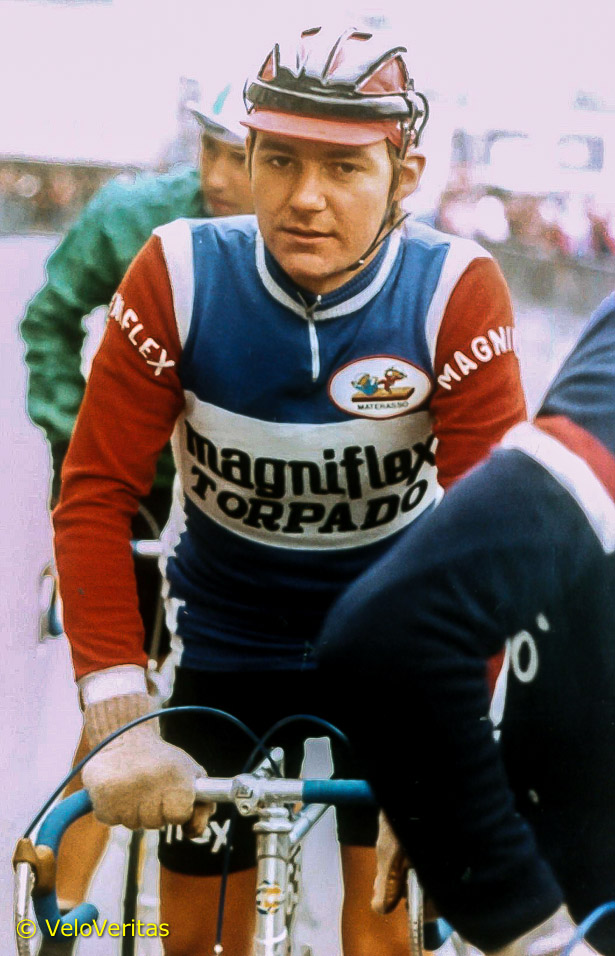
Did you enjoy the 70’s Italian lifestyle?
“I liked living with the families who kindly hosted me at times there. To get to know people in such personal settings was a real privilege and taught me much about getting along with people in general.
“I loved the Italian countryside, especially in the warmer months and I was glad to have a job which allowed me to travel constantly through such a beautiful country and to visit so many towns, large and small.
“My life as a cyclist really didn’t afford me much time for socialising and I was not generally given to partying or even hanging out all the time with my team mates.
“I was always the quiet guy and my friends there were much the same.
“I think Italians were a very friendly people, generally very social and knew how to enjoy themselves in company. Staying in hotels and eating amongst many teams we always had a lot of laughs and heard news and rumours of the day as a matter of course. Usually the mechanics and masseurs had us in stitches with stories of their adventures after hours in the towns we stopped in during stage races.
“It was always the sprinters who laughed hardest and whose stories were so often hilarious.
“I always thought that I would return to Italy just to see the mountains and lakes there without being cross-eyed from the effort of racing, something my wife and I have been fortunate enough to do a number of times now over the years.”
Did you learn Italian?
“When I arrived in Italy in early 1974 with David Allan, neither of us spoke a word of Italian.
“I used to buy things with dictionary in hand and at first was the butt of many jokes from my team mates who made fun of me with friendly insults which I gradually made sense of and tried to return in kind.
“Italian is not the hardest of languages and because I spent so much time in the company of locals who were associated with cycling, I picked it up and even began thinking in Italian before my first year had passed there.
“Some time in my second year I could understand the local dialect fairly well, which came from being really immersed in the life at hand.”



